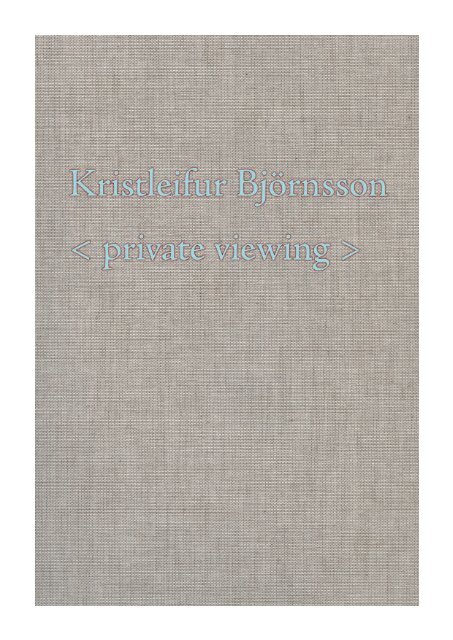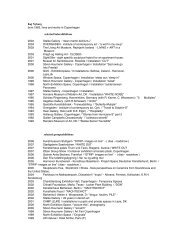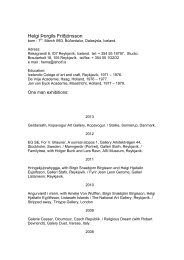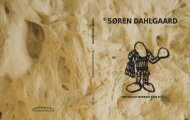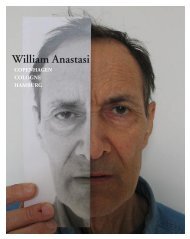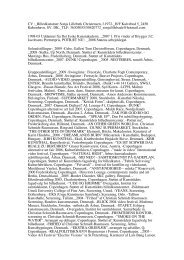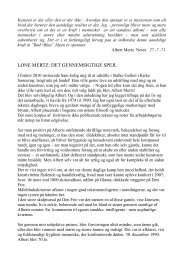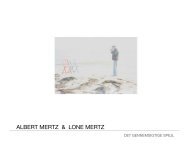Untitled - Stalke
Untitled - Stalke
Untitled - Stalke
You also want an ePaper? Increase the reach of your titles
YUMPU automatically turns print PDFs into web optimized ePapers that Google loves.
Kristleifur Björnsson< Private Viewing >A Exhibition held in the artist’s studio in Kreuzberg - Berlinfrom 20th of september to 22nd of oktober 2009Text by Jacob LillemoseText by Reinhard BraunExhibition Photos from < Private Viewing > _ < My Girls >Exhibition Photos from < Private Viewing > _ < Girls >Exhibition Photos from < Private Viewing > _ < Other >CVp. 2 - 4p. 5 - 9p. 2 , 4 , 5 , 10 - 15p. 7 , 9 , 16 - 22p. 23 - 24p. 25 - 26| p. 1 |
Do I Own You Because I See You?Life online is fascinating and seductive. It servesup a new world of seemingly endless possibilities ona silver screen right in front of you. You do not evenhave to budge to experience it. All you have to do istype and click – and it is all there, “for your eyes only”.Comfortably seated in your chair you watch yourwildest dreams come true. From this perspective, realityoutside the screen seems trivial and limited. This isvirtual reality at its best, in its essence, and you aresmack at the centre of it.| < My Most Beautiful Keira > _ 2009 _ Photo Collage _ < My Girls > | Text : Lillemose | p. 2 |
Kristleifur Björnsson’s work series My Girlsoriginates in this ‘use’ of the Internet as a privatealternative reality. The series consists of larger-than-lifesizephoto collages of four famous actresses. The imagesare all found on the Internet, printed on Björnsson’sstudio printer and pinned to the wall with four nails,sometimes with a frame around them. Each collage ismade up of hundreds of A4 prints that, put together,create the four images of the actresses. The presentationdoes nothing to hide the production process. Rather itaccentuates the unsophisticated do-it-yourself style andthe inexpensive, homemade quality to say that althoughthe works are exhibited in gallery spaces their true placeis on the walls of a private room alongside other fanposters. They really belong to the room of the guy whocalls the actresses “my girls”.The images look like snapshots that havecaught the actresses casually, lovingly smiling at, say,a boyfriend, not at the kind of anonymous publiccelebrities usually pose for. It is needless to say thatthey are not private photos, quite the opposite actually,but that is the feeling you get when you see them. It isyou and the girl(s) sharing a moment, with the publicout of sight and out of mind. My Girls captures theambivalence of this feeling; the viewer is trapped in adigital no-man’s-land between romantic intimacy andillusion.In a way My Girls brings the concept of theCartesian ego up to date with the Internet era, so tospeak. René Descartes’ ego famously proclaimed, “Ithink, therefore I am”. The Cartesian ego, accordingto the most common interpretation of this dictum,believes itself to be the centre of the world and in a waythat is true of course. Yet the Cartesian ego is not incontrol of the world around it. Actually it has no certainknowledge of it; after all, the main thrust of Descartes’argument is marked by an extreme scepticism. All theego can do is to create its own world by thinking.Similarly, the ego indirectly portrayed in My Girls isat the centre of its own world. “I surf, download, printetc., therefore I am”, it says. But like the 17th-centuryversion this kind of egocentric existence involves adetachment from the outside world. For Descartes thedetachment was a philosophical question, for Björnssonit is a question of psychology and of technology. Ormore precisely, of the interplay between the two and theemotions and ideas that this interplay creates.Usually technology is believed to be psychologically‘neutral’, in the sense that it is perceived as a toolthat enables you to get practical jobs done in theworld, whether online or offline, without emotionalinvolvement or abstract reflection. Whilst this mayhold for the use of such archetypal tools as a hammer,it is a different story with the technology we use today.Friedrich Nietzsche warned us that the “tools of ourwriting are also working on our thoughts”. He wasreferring to the typewriter’s (negative) influence on histhinking, yesterday’s technology, but the essence of thestatement nevertheless still has validity and relevancein relation to ‘the digital typewriter’, the computer, andeven more so to its extension, the Internet. Like everycommunications technology, the Internet is inextricablytwinned to ways of feeling, thinking and interactingwith the world. It defines the user, practically as wellas conceptually. Although most users believe they arefree to invent and express themselves as they like, theiractivities and movements are in fact predetermined bythe general program run by the Internet.The same goes for the ego in My Girls. Rather thanexpressing individuality, it is an expression of the powerthat the image flow of the Internet exerts on individuals.The ego is caught in a world of images, or what JeanBaudrillard calls “simulacra”, images with no referenceto the world outside themselves. These images haveabsolute authority and all the ego can do is reproducethem, pin them to the wall and worship them. KarlMarx would add, “with a false consciousness”.The love story that unfolds through technologyin My Girls is not exactly a happy one. The adequatedescription would probably be bitter-sweet. For onething, it is one-sided. Like a virtual voyeur the ‘narrator’eyes ‘his’ girls in secrecy, hidden behind the screen. None| Text : Lillemose | p. 3 |
of the girls can see him; none of the girls know what heis up to. Those are the conditions in which the love storyis told. And that is what makes it so simple, so good andbeautiful. As opposed to offline love stories, My Girlsdoes not require the parties involved to be in physicalcontact, that might only result in quarrels and confusionanyway. It is a relationship in which there is no placefor mistakes and disappointments. Who could wish foranything else? It even allows you to see more than onegirl at a time without cheating on the others!Of course, the downside to this lack of contactis solitude. However, not exclusively in a tragic sense,because the end of solitude would mean the end of therelationship. That is the irony of it. Thus, the narratorhas to love his isolation as much as his loves his girls.One of the assumptions of so-called queer theoryis that the male gaze reduces the female to an objectof desire in order to take control and possession ofher. At first sight you might think this is the case inMy Girls, if it were not for the fact that Björnssonoverstates the point only to disclose its true premises,its “hidden reverse”, as Slavoj Zizek would say. Herethe male gaze does not own its object of desire. Onthe contrary, the object of desire represents that whichcannot be owned, least of all by the gaze, and as such itreflects a dispossessed male. So rather than being aboutpossession proper My Girls is about the obsession toposses. The male uses all the technology he has gotto make the girls his girls, only to realize that this isimpossible. He blows up the images far beyond life-sizeto give them a strong presence, but that only makesthem more alien, more distant. The bigger the collagesare, the more unachievable the goal seems.Thus My Girls tells about colourful possibilitiesas well as the darker sides of online life and confrontsus with the hen-and-egg question whether our solitudeleads to an obsession to possess or whether ourobsessions to possess lead to solitude.Jacob Lillemose| < My Shannyn > _ 2009 _ Photo Collages _ < My Girls > | Text : Lillemose | p. 4 |
Contagious AffairsIt has become a commonplace observation that themedia and advertising in general – as an aesthetizationof the public (and increasingly also of the allegedlyprivate) sphere, as a “framing by media dispositifs” (TomHolert) – expose us to a constant barrage of idols, ideals,dreams, desires and ideologies, “beautiful images or ideas| < My Girlfriend Natalie > _ 2009 _ Pencil Tracing ( H6 ) _ < My Girls > | Text : Braun | p. 5 |
that are preserved by the picture for no other reasonthan because they only ever exist in the picture, becausethey have only ever been created by the picture” (GillesDeleuze). It is an equally commonplace observationthat artistic practice, to the extent it confronts this factin the first place, always does so in critical terms and/or in terms of strategic affirmation. The increasingperformativity of the pictures provokes on the part ofartists a specific critical awareness of pictures, which –in a manner of speaking –derails this performativity inorder to make possible a different treatment of thesepictures. By doing so, art intervenes in the relationshipbetween picture and desire, in the power of pictures toevoke desire, a desire that has served as a cultural motoralready for quite some time and as a centre of gravitationfor countless industries that cluster round it.What is the likely outcome, one may ask, if this desireis not only taken seriously but literally? What happensif this desire becomes in its turn the motor of artisticproduction?„I Would Love to Make Her Radiate“ is the titleof one of Kristleifur Björnsson’s most recent works,a self-made line of lingerie presented under glass insumptuous wooden caskets. This is supplementedby lingerie ads Björnsson has lifted from fashion andwomen’s magazines and subjected to artistic secondguessing.He has covered the usually full-page ad withtracing paper and traced the lingerie: the result is“Succeeding Desire” (2008/2009). This was precededin 2007/2008 by “This would suit her”, a series ofphotographs depicting various items of lingerie spreadout on a bed. These have obviously not landed there in ahaphazard manner, they’ve been carefully if mysteriouslyarranged as if they were meant to serve some obscurepurpose.These works seem to address a desire for –female – beauty, for sumptuous materiality, for theembellishment or the reworking of – female – bodies;they circle round affects generated by the desire for thesebodies. In a manner of speaking they are to be read asan (indirect, medialized) re-enactment of these bodies,as an attempt to establish and represent a contradictory(because medialized) intimate relationship with thesebodies. In this way Björnsson creates a specific spacefor the – male – affirmation of that intimacy. This iswhy a certain sense of unease is inherent in these works,which has its origins in the fact that they are entangledin structures of desire, in their adaptation of structuresof perception, in the affirmation and voyeurism thatflare up in the absence of a critical distance to separatethem from their “obscure object of desire” (Luis Buñuel).This sense of unease is all the more remarkable as theseworks do not constitute any immediately recognizabletaboo breaking or lewdness. It has to do with the factthat they raise the question of the individuality of desire.Is there such a thing as individual, authentic desire inthe first place? Or is it the case that we are off kilterbecause we can never make this desire completely ourown?Björnsson takes up the discourse centring onfashion, bodies, beauty, politics, pop culture and identitypolitics to turn it inside out and switch it into overdrive.Examples of this are the tracings of the “SucceedingDesire” series, which display a downright manicpreoccupation with the female body, its beauty (whichis entirely produced by the medium and is thereforepurely fictional) and the ambivalent desire for thosebodies. The ensembles in the “I Would Love to MakeHer Radiate” series also make it clear that the focusis on the production process, the material realizationand not on a strategy of representation. They are at thesame time objets d’art and sumptuous presents, giftsand commodities. The lingerie items are presented andpinned down in oak cases with a plexiglas lid; they arenot intended for wearing . The conspicuously colouredseams prove beyond any doubt that, while all the itemsare handmade, the person who made them has notyet fully mastered the requisite skills. The struggle forhandcraft perfection; the tracing method, which leavesthe originals curiously untouched; the purposeful| Text : Braun | p. 6 |
| < I Would Love to Make Her Radiate _ For the Girl in Quiberon > _ 2009 _ Hand Made Dessous _ < Girls > | p. 7 |
arrangement of the lingerie items on the bed; all thisevidence of interventions, interference, alteration andre-interpretation, i. e. of the presence of the artist in hiswork, seem to point to an obsession, a desire which isbeing addressed here and put centre stage. One wouldhave to ask though whether there is any fulfilmentin sight for this desire. Is it not the case that the verycharacter of Björnsson’s works as a series suggests theimpossibility of any kind of fulfilment? “SucceedingDesire”? “I Want to Make Her Radiate”? Are not thevery titles marked by melancholy and angst?In these series Björnsson engages with an unspokentaboo that is at the same time generated and suppressedby the visual culture of advertising. That taboo concernsthe phantasmagorias and desires kept in circulation byadvertising and the implicit ban on taking them literally,on tracking them down and giving them materialexistence. After all, their “fulfilment”, their “realization”is supposed to be channelled towards other culturalpractices, in particular towards consummation throughpartial consumerist satisfaction. This means thatthese series are neither guided by a critical awarenessof this particular kind of wishful thinking that owesits structure to the medium of advertising nor by itssublimation through consumerist behaviour. They are infact guided by speculations about those strategies thatare seen at work in the appropriation and modulationof this wishful thinking, about the possibilities of wishfulfilment and the circularity of the triad desire, subjectand representation. In his latest series Björnsson drawsour attention to the ambivalent entanglement governingthe performativity of pictures – and bodies – by usingit as his point of departure for his work. And there isno doubt that the focus is on the bodies despite theirostensible absence. It is in fact their very absence, theirrepresentation by what amounts to no more than aparaphrase that evokes them all the more powerfully inthe mind of the observer.All this gives Björnsson a unique position withinthe scenario of those contemporary artistic practicesthat are directed towards a discourse about desire, mediaand commodities; about the body as the locus of realdesire on one hand and phantasmagorical productionon the other. Our craving for beauty, the circulationand commodification of ideals of beauty in countlessmedia channels, “all the bodies I know and those Iwant to know” (Ultravox, 1977) – Björnsson drawsus into a closed loop involving emotions and desiresthat we recognize both as belonging to us and, at thesame time, as not belonging to us in any meaningful,authentic sense that relates to us as individualizedsubjects; desires that we would love to succumb to ifwe did not feel at the same time the need to try anddistance ourselves from them, as we recognize them asessentially commodified (and power hungry) desires. Aswe contemplate Björnsson’s works, we oscillate betweenwanting to voice criticism and wanting to succumb toseduction; we are drawn into an arena in which differentforms of identity, obsessions, phantasmagorias as wellas power and control are renegotiated (as opposedto represented). They stake out an affective space inwhich materials, pictures and the interventions inpictures themselves become the actors that re-enactthose negotiations. They demonstrate what happenswhen desire is taken literally and put before our eyes,when it is freed from its medium-generated framesand its conventionalizations and/or when these areisolated, displayed in their own right and made ultravisible.Björnsson intervenes with his most recent worksprecisely in those orders that ensure the consistencyof this desire as well as the consistency of the policiesaffiliated with the desire.If art is the discourse that produces a specificcritical knowledge about pictures, the production ofthat criticism is located in Björnsson’s work in thatconstellation in which his most recent work addressesthose mechanisms of seduction that have alwaysattempted to silence criticism and to neutralize it.His works replicate the different arenas of a societythat is divided against itself, oscillating between| Text : Braun | p. 8 |
normalization and excess, triviality and spectacle,public voyeurism and new “Biedermeierlichkeit”, i.e.an a-political, escapist stance, a kind of cocooning in asegregated private universe. They use pictures both toput bodies centre stage and to make them disappear,to produce subjectivity and to pacify it, smothered injoint desire. They deal with a relationship of mutualcontagion between pictures, commodities and subjects, arelationship that Björnsson has entered into himself andabout which his works have “tales to tell”.Reinhard Braun| < Succeeding Desire _ Change > _ 2009 _ Pencil Tracing ( HB / H3 ) _ < Girls > | Text : Braun | p. 9 |
| < Mindi ; My Indian Flower > _ 2005 / 2009 _ Photo Collage / Pencil Tracings ( H6 ) _ < My Girls > | p. 10 |
| < Mindi ; My Indian Flower > _ 2009 _ Pencil Tracings ( H6 ) _ < My Girls > | p. 11 |
| < My Most Beautiful Keira > _ 2009 _ Photo Collage _ < My Girls > | p. 12 |
| < My Shannyn > _ 2009 _ Photo Collage / Pencil Tracing ( H6 ) _ < My Girls > | p. 13 |
| < My Shannyn > _ 2009 _ Pencil Tracing ( H6 ) _ < My Girls > | p. 14 |
| < My Girlfriend Natalie > _ 2009 _ Pencil Tracing ( H6 ) _ < My Girls > | p. 15 |
| < Every Second Day _ Melabudin / Reykjavik > _ 2009 _ Analog Photography _ < Girls > | p. 16 |
| < Beside Picasso _ Alte Nationalgalerie Berlin > _ 2009 _ Analog Photography _ < Girls > | p. 17 |
| < I Would Love to Make Her Radiate _ For the Girl in Quiberon > _ 2009 _ Hand Made Dessous _ < Girls > | p. 18 |
| < I Don’t Want to Know Your Name _ Berlin > _ 2007 _ Analog Photography _ < Girls > | p. 19 |
| < This Would Suit Her _ The Loft _ Day > _ 2007 _ Analog Photography _ < Girls > | p. 20 |
| < Succeeding Desire _ Change > _ 2009 _ Pencil Tracings ( HB / H3 ) _ < Girls > | p. 21 |
| < I Don’t Want to Know Your Name _ Berlin > _ 2009 _ Digital Photography _ < Girls > | p. 22 |
| < Slopes / Hlidar > _ 2009 _ Analog Photography _ < Other > | p. 23 |
| < Lego _ Yellow Dog , Parrot > _ 2006 / 2007 _ Lego Sculptures _ < Other > | p. 24 |
Kristleifur BjörnssonCVBorn in Reykjavík / Iceland , on the 12th of november 1973 .Begun studying at the HGB - Academy of visual arts , Leipzig / Germany 1995 . Under theguidance of prof. Timm Rautert from 1998 until graduating with Excellency July 2003 .Now working and living in Berlin / Germany .Solo Exhibitions :2009 < Private Viewing > , Studio Kreuzberg , Berlin / Germany .2009 < My Shannyn > , Gallerí Gangur , Reykjavík / Iceland .2009 < Hlíðar / Slopes > , <strong>Stalke</strong> Gallery , Copenhagen / Denmark .2008 < Hlíðar / Slopes > , Skaftfell , Seyðisfjörður / Iceland .2005 < Mindi ; my indian flower > Asmundarsalur / Iceland .2003 < My Girlfriend Natalie > , HGB , Leipzig / Germany .2001 < Hlidar / Berghaenge > , HGB , Leipzig .1998 < 10 Voerdur > , Int. Airport , Egilsstadir / Iceland .Group Exhibitions :2009 < Beautiful Illusions > , Galerie Maurer , Frankfurt am Main / Germany .2009 < Master Class of Prof. Timm Rautert > , Galerie Kleindienst , Leipzig / Germany .2009 < Flash at a Moment of Danger > , Listasafn Árnesinga , Hveragerði / Iceland .2008 < Street & Studio > , Fotomuseum Volkwang Essen , Essen / Germany .2008 < Mindi ; My Indian Flower > , Steirischer Herbst , Art Festival , Graz / Austria .2008 < Yellow Dog > , VIP Event - Green Squere , Copenhagen / Denmark .2008 < Master Class of Prof. Timm Rautert > , UBS Bank , Zurich / Switzerland .2008 < Palinsesti 2008 > , Rassegna d’Arte Contemporanea , San Vito al Tagliamento / Italy .2008 < Street & Studio > , Tate Modern , London / England .2008 < Hot Icelandic > , <strong>Stalke</strong> Galleri - <strong>Stalke</strong> up North , Copenhagen / Denmark .2008 < Gallery Poulsen visits Magasin > , Gallery Poulsen , Copenhagen / Denmark .2008 < Master Class of Prof. Timm Rautert > , Galerie Loehr , Moenchengladbach / Germany .2008 < Island i Borup > , <strong>Stalke</strong> Galleri - <strong>Stalke</strong> out of Space , Borup / Denmark .2007 < Forschen und Erfinden > , Fotomuseum Winterthur , Winterthur / Switzerland .2007 < Update > , <strong>Stalke</strong> Galleri , Kirke Sonnerup / Denmark .2007 < Ohne Shatten > , Galerie Eigen + Art , Leipzig / Germany .2006 < Vor aller Augen > Festival , Bâtiment d’art , Genf / Schweiz .| CV | p. 25 |
2005 < White Night Lover > Expositions - Gallery Conde , Paris / France .2005 < My Shannyn > , Rencontres Internationales de la Photographie , Arles / France .2005 < Reality > , <strong>Stalke</strong> Galleri , Kirke Sonnerup / Denmark .2004 < Dreamscapes > , Aeroplastics Contemporary , Bruxelles / Belgium .2004 < Synd & Hljod > , Klink og Bank , Reykjavík / Iceland .2003 < Silver & Gold > , Essen - Dresden - Glückstadt - Wolfsburg / Germany .2002 < Artists of the Gallery > , Gallery 20.21 , Essen / Germany .2001 < United Cantonas Fan Club > , HGB Leipzig / Germany .1998 < Accumulator #1 > , Leipzig / Germany .1996 < Back Flash > , Leipzig / Germany .Art Fairs :2009 < Every Second Day > . Art Copenhagen - the nordic art fair , Copenhagen / Denmark .2008 < This Would Suit Her _ The loft > . Art Copenhagen - the nordic art fair , Copenhagen / Denmark .2007 < Lego - Yellow Dog , Parrot > , Art Copenhagen - the nordic art fair , Copenhagen / Denmark .2005 < My Shannyn > , Rencontres Internationales de la Photographie , Arles / France .2002 < Dettifoss > , Kunst Köln , Cologne / Germany .Grants / Fellowships / Prizes :2009 Listamannalaun / The Icelandic State Scolarship for Visual Arts .2008 Listamannalaun / The Icelandic State Scolarship for Visual Arts .2001 < United Cantonas Fan Club > . The Price of the Rectorate Colleagueium , HGB / Leipzig / Germany .Catalogues :< Lego _ Yellow dog , Parrot > 2007 . Ed. 500 .Publications :< Flash af a Moment of Danger > ; Listasafn Árnesinga . 2009< Common Affairs > ; Steirischer Herbst . 2008 . Steirischer Herbst Art Festival .< Close the Gap > ; Meisterklasse Rautert . 2008 .< Palinsesti 2008 > ; Resegna d’Arte Contemporanea . 2008 . Palinsesti .< Street & Studio > ; An Urban History of Photography . 2008 . Tate Publishing .< Forschen und Erfinden / Research and Invention > . Fotomuseum Winterthur . 2007 . Scheidegger & Spiess .< Rencontres 2005 > ; Rencontres de la Photographie Arles . 2005 . Actes Sud .< Vor Aller Augen > ; Photography from Leipzig . 2005 . Kerber Edition Young Art .< Silver and Gold > ; Klasse Rautert / Fotografie . 2003 . Verlag der Buchhandlung Walther König .| CV | p. 26 |


